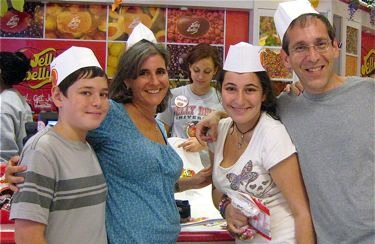A couple of months back, on our trip to Nagal Og near the Dead Sea, we picked up a friend of our youngest son.
Aviv’s classmate Nesya lives in what is known as an illegal outpost deep in the West Bank. It is so tiny we couldn’t find it on any map until I set Google to maximum zoom and slowly traced a winding road north from the settlement of Kfar Adumim. The resulting satellite image revealed an enclave of just eight homes.
The entrance to Mitzpe Hagit, which was established in 2001 and named after Hagit Zavitsky, who was killed in Wadi Qelt in 1995, is more like a gravel driveway than an actual road. The houses are arranged along a single street with a fenced off “zimmer†(Hebrew/German for “country innâ€) at the end. Maariv wrote about the latter, pointing out that the bed and breakfast’s owner had built a semi-Olympic sized pool overlooking the Jordan Valley.
Up until now I had read about these hilltop encampments but never seen one up close. The homes were not the corrugated shacks I’d imagined, but neither were they proper buildings. Nesya’s house consisted of a modified caravan on stilts, a broken window facing out and a sort of half-completed wooden awning that reminded me of a Tanzanian safari lodge. Around the back there was a large yard where 20 some goats lived with an equal number of turkeys, chickens and menacing, unceasingly barking dogs.
Nesya told us how she wakes up at 4:30 AM to milk the goats (taking a few squirts for her own breakfast) before catching a school bus into Jerusalem. The family makes its own cheese and eats the eggs from the motley mix of fowl.
It all sounded like an idyllic life – nestling high on a mountain, living one with the land, organic and serene – except for the inseparable politics that have deemed Nesya and her family a statistic which, depending on the narrative you choose, marks them either as patriotic pioneers or an obstacle to peace.
What is clear is that Nesya and her family never received permission to build their house, which is perhaps why her parents still own a home in the nearby settlement of Kfar Adumim.
Driving home, we continued on the road, passing Ma’aleh Michmas and several other settlements of varying sizes before reaching a very large, very red sign that warned in utterly unsubtle terms out that it was forbidden for Israelis to continue – we had reached Ramallah. A sharp left and we were in the Jerusalem suburb of Pisgat Ze’ev. Twenty more minutes and we were home.
No matter where you are in the political spectrum of the Middle East, you owe it to yourself to see what a hilltop outpost in the West Bank really looks like. And if you go, be sure to say hi to Nesya and her goats.




{ 1 comment… read it below or add one }
It’s nice to be able to put yourself up a farmstead for free by building an illegal settlement. Next time you’re down near Kfar Adumim, try — if you can — to turn into the nearby Bedouin encampment. The Bedouins, who have lived in the same place since 1948, when they were settled there by the Jordanians after being displaced by Israeli independence, are treated as “squatters” by the settlers. My spouse, Yehiel, just reported to me from there that the bulldozers have cut them off from the road.